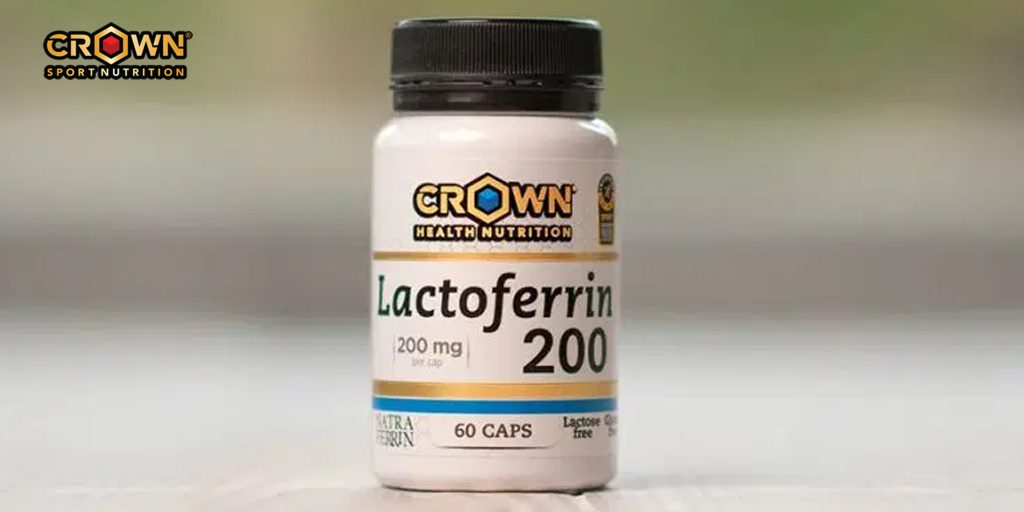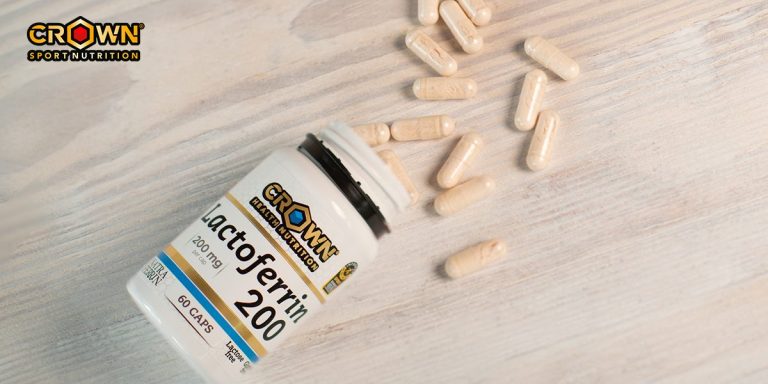Abstract
Lactoferrin, which exists widely in human and mammalian milk, is a multifunctional glycoprotein with many functions, such as immune regulation, anti-inflammation, antibacterial, antiviral, and antioxidant. These extensive functions are largely attributed to its high affinity for iron. It belongs to the transferrin protein family and is the main iron-binding protein in human milk. Moreover, it is non-toxic and compatible with other nutrients, including natural supplements.
The present short review summarises the most relevant aspects of lactoferrin’s mechanism of action, biological function and metabolism. It describes the different dietary sources of lactoferrin (including supplements) and provides recommendations on lactoferrin intake to support health and exercise performance in physically active individuals, including endurance, strength and power athletes.
The available evidence indicates that oral lactoferrin supplementation can have a notable impact on health and physical performance, particularly in physically active individuals engaged in endurance training. Lactoferrin is a safe and well-tolerated supplement. It avoids the gastric distress associated with traditional oral iron supplementation. An effective dose to support health and exercise capacity in healthy individuals ranges from 100 to 200 mg daily, taken once or twice 100 mg doses/day, for a period of 1 to 3 months.
Introduction
Lactoferrin (formerly known as lactotransferrin) is a glycoprotein with a molecular weight of about 80 kDa, which shows high affinity for iron.1 It belongs to the transferrin protein family and is the main iron-binding protein in human milk.2 Lactoferrin is produced and released by mucosal epithelial cells and neutrophils in various mammalian species, including humans, bovines, cows, goats, horses, dogs, several rodents and fish.2
Besides mammalian milk and colostrum, where lactoferrin, present at a concentration of 7 g/L, is the second most abundant protein after caseins, it is present in tears, saliva, vaginal fluids, semen, nasal and bronchial secretions, bile, gastrointestinal fluids, and urine. Furthermore, a considerable amount of lactoferrin is found in secondary neutrophil granules (15 g/106 neutrophils) and other fluids such as blood plasma and amniotic fluid.2
Many studies have demonstrated lactoferrin tolerance in humans.2 It has been approved by the FDA (US) and the European Food Safety Authority as a dietary supplement in food products.3 However, as oral lactoferrin is susceptible to peptic digestion in the stomach, it cannot easily access the digestive tract. To overcome this problem and to improve the nutritional and, when applicable, therapeutic effect of lactoferrin, the use of microparticles or liposomes has been shown to improve its action by the improvement of stability against gastric degradation and facilitating the interaction with the intestinal membrane and with lactoferrin-specific receptors.4 As such, oral lactoferrin supplementation has attracted interest due to its multifaceted physiological and protective functions, including regulation of iron absorption in the bowel; modulating immune function, antioxidant, anti-inflammatory, anti-microbial and anticancer effects.2 These properties suggest that oral lactoferrin supplementation could impact health and influence physical performance and recovery in physically active individuals.3
Key Mechanisms of Lactoferrin in Humans
Each lactoferrin molecule can bind two ferric (Fe3+) ions, one in each of its two lobes, with extremely high affinity. Indeed, lactoferrin retains bound iron even at acidic pH (as low as 3–4), allowing lactoferrin to regulate the levels of free iron by sequestering free iron in biological fluids and inflamed tissues.5 These properties give lactoferrin potent bacteriostatic and antioxidant functions: it starves microbes of the iron they need for growth and protects host tissues from iron-catalysed oxidative damage.5 Indeed, many of lactoferrin’s biological activities (antimicrobial, anti-inflammatory, etc.) are closely related to its ability to tightly bind and control iron availability in fact, lactoferrin lowers hepcidin (a hormone that restricts iron release), being able to prevent iron deficiency anaemia.6 Furthermore, orally administered bovine lactoferrin significantly increased its probiotic activity both in adults and in infants, including prematurely born.2 Lactoferrin displays also a potent antiviral activity against Cytomegalovirus (CMV0, Herpes simplex virus (HSV), Human immunodeficiency virus (HIV), Human hepatitis C (HCV) and human hepatitis B (HBV) viruses. The antiparasitic activity of oral lactoferrin appears to involve interference with iron acquisition in some parasites, e.g., Pneumocystis carinii, or acting as a specific iron donor in others, such as Tritrichomonas foetus.2
Lactoferrin contributes to iron absorption and distribution in various body compartments in the small intestine. Specific lactoferrin receptors on enterocytes mediate the uptake of lactoferrin-bound iron, which is absorbed without causing the pro-oxidant stress associated with free iron in the gut.7 Indeed, adding bovine lactoferrin to diets can improve iron uptake and status in infants and pregnant women.8
Lactoferrin enters the bloodstream and is able to reach bile and cerebrospinal fluid. It can cross the blood-brain barrier by receptor-mediated transport, delivering iron to the brain in a regulated manner.9 Lactoferrin supports the maintenance of systemic iron balance, acting as a complementary iron transporter to the function of transferrin (the primary plasma iron carrier). It can pick up iron in one locale and, via specific receptors, deposit it in another, helping to distribute iron to where it’s needed while keeping it away from pathogens or catalytic reactions. It provides an extra layer of control over iron homeostasis at mucosal surfaces and within certain tissues.10
Lactoferrin is a key mediator of nutritional immunity with potent nutraceutical, immunomodulation and anti-inflammation effects.2 Because nearly all pathogens require iron for replication, lactoferrin’s high-affinity iron binding is a powerful antimicrobial mechanism to scavenge free iron in secretions and inflamed tissues, effectively starving bacteria and fungi of this essential element.11 Notable for athletes, lactoferrin supplementation has been shown to reduce pro-inflammatory cytokines like interleukin-6 (IL-6), indicating a reduction in systemic inflammation, which may optimise recovery between workouts.12 Furthermore, Lactoferrin can also act as a prebiotic and support gut integrity. Peptides released from lactoferrin digestion promote the growth of beneficial gut bacteria (e.g., Bifidobacteria and Lactobacilli). A healthy gut microbiome and intact intestinal barrier are vital for nutrient absorption, which may reduce exercise-induced gastrointestinal distress that could indirectly benefit performance by ensuring effective uptake of nutrients in athletes.13
The available evidence suggests that lactoferrin is an immunomodulatory agent that balances effective antimicrobial activity with control of inflammation. By withholding iron from microbes, limiting oxidative damage, and fine-tuning cytokine responses, lactoferrin serves as a critical link between iron metabolism and immune function for humans.11 Additionally, lactoferrin could also optimise performance capacity (especially for endurance athletes) and recovery, by attenuating exercise-related iron deficiency, inflammation, oxidative stress, and infections.12
Sources of Lactoferrin for Humans
Bovine milk and colostrum-derived products are the predominant natural dietary sources of lactoferrin.14 In colostrum (the first milk after childbirth), lactoferrin concentrations are extremely rich (several grams per litre) and remain about 1–2 g/L in mature human milk.14 Lactoferrin is a component of the whey protein fraction in all mammalian milks, but their lactoferrin content is lower compared to human breast milk 14. For instance, cow’s milk provides about 0.1–0.3 g/L of lactoferrin in standard mature milk, although bovine colostrum can have higher levels (~ 2–5 g/L) before declining after the first few days of lactation15. Fermented dairy foods (yoghurt, cheese) can still have some lactoferrin, but high heat treatments used in dairy processing (e.g. high-temperature pasteurisation or milk powder production) may denature some of it.
Lactoferrin Supplementation for Humans
The vast majority of supplemental lactoferrin on the market is naturally derived from bovine milk. Lactoferrin can be extracted using filtration and ion-exchange chromatography techniques from skim cow’s milk or cheese whey (a by-product of cheesemaking) on a large scale.16 The captured lactoferrin is then eluted (e.g., using salt solutions), and the protein is further purified, concentrated, and dried into a powder of high purity (>95% pure protein) bovine lactoferrin form.16 In addition to bovine milk extraction, colostrum products (powders or capsules) represent another commercial source of lactoferrin.17 However, purified lactoferrin for pharmaceutical/nutraceutical use is still predominantly derived from regular cow milk due to the large volumes available and well-established processing methods. In addition, a recombinant form of lactoferrin is produced by inserting the gene for lactoferrin into an expression system (such as microbes, cell cultures, or transgenic animals) to synthesise the protein in a controlled setting. This allows the production of human lactoferrin, particularly produced for therapeutic purpose, without needing human milk donations. Studies have confirmed that recombinant lactoferrin from transgenic cow milk exhibits comparable biological activities to natural human lactoferrin.18 Additionally, it is worth mentioning that bovine lactoferrin is safe (as previously mentioned, EFSA approved it as a novel food ingredient in Europe in 2012), whereas recombinant lactoferrin (especially if produced by novel methods like transgenic plants or animals) undergoes careful safety evaluations before approval.
Lactoferrin Supplementation and Exercise Performance: Recommended Protocols and safety
Due to its iron binding capabilities, role as immunomodulator supporting the immune status, lactoferrin has been proposed as an effective nutritional supplement for physically active individuals, particularly to optimise endurance performance.3,19 Because lactoferrin does not function like caffeine, a single dose of lactoferrin does not immediately impact health markers and performance in physically active individuals. Its mechanisms (iron modulation and immunological effects) generally require time to influence immune status and performance.20 Conversely, chronic supplementation induced benefits such as improved iron stores (higher haemoglobin and ferritin), reduced inflammation (lower IL-6 and hepcidin activity), and enhanced antioxidant capacity.20 These changes can prevent performance decrements associated with iron deficiency and excessive training stress.21
For healthy individuals, training for endurance ~100 mg (taken in one daily intake e.g., at breakfast or post training), to prevent iron depression or 200 mg (taken in two daily 100 mg doses, e.g., one dose at breakfast and one dose post training) for those with low ferritin or haemoglobin levels for 8 to 12 weeks showed to be effective to respectively improve iron status maintain or increase VO2 max22 either when consumed alone or combined with low-dose iron (which lactoferrin can make more effective).21 Furthermore, strength and power athletes may use a similar dose (e.g., 200 mg/day) primarily for recovery support and to take advantage of lactoferrin’s anti-inflammatory effects.22 Higher doses (up to 400 mg/day ingesting in two intakes of 200 mg each) have been tested in special clinical population without safety issues, but reaching such higher amounts may not be necessary for most athletes with acceptable iron and haemoglobin status, at least they are looking for additional immune/antioxidant benefits.20 A practical strategy, therefore, could be to start at ~100 mg per day and increase to 200 mg if a greater effect is needed. There is likely a ceiling effect; however, ultra-high doses (e.g. grams of lactoferrin) are not recommended outside of a specific medical environment, and most commercial supplements provide 100–300 mg per capsule.
Lactoferrin is a safe and well-tolerated supplement. It avoids the gastric distress associated with traditional iron pills and has no stimulant or hormonal effects. Lactoferrin can be consumed at high levels with no known health risks. Therefore, with its high tolerability, lactoferrin does not typically require “cycling off” for safety. Some athletes periodize lactoferrin use, increasing its dosses during heavy workouts or altitude training phases (when iron needs and infection risk are highest) and potentially pausing during off-season if dietary iron is appropriate. Since lactoferrin is food-derived and safe, long-term daily use is acceptable if it provides noticeable benefits.
Conclusions
Oral lactoferrin supplementation could have a notable impact on health and physical performance. It has a safety profile superior to traditional iron supplements with almost no gastric distress. An effective dose for healthy individuals ranges from 100 to 200 mg daily, taken once or in two 100 mg doses, respectively, for 1 to 3 months. Lactoferrin acts as a multipurpose support nutrient, supporting immune status and antioxidant capacity, which in turn optimise recovery, impacting training capacity and improving performance over time.
<h3 style="text-align: center;">10% DISCOUNT ON THE WEBSITE WITH THIS CODE:</h3>
<h3 style="text-align: center;"><span style="color: #ff0000;">CROWN10</span></h3>
<h3 style="text-align: center;">*Free shipping on orders over 25€.</h3>
<div class="dfd-info-box clearfix style-01 layout-04 fichaproducto">
<div class="dfd-animate-container">
<div class="icon-wrapper">
<div class="module-icon">
<div class="hover-layer"> </div>
<p><img class="wp-image-189036 aligncenter" src="https://edh3ifkay3d.exactdn.com/wp-content/uploads/2025/03/1-8437028069122.jpg?strip=all&lossy=1&ssl=1" alt="imagen Lactoferrin 200" width="594" height="594" /></p>
</div>
</div>
</div>
<div class="dfd-animate-container">
<div class="content-wrap ovh">
<h3> </h3>
<h3 class="product_title entry-title">Lactoferrin 200</h3>
<div class="description">Lactoferrin 200 from Crown Sport Nutrition is an advanced supplement that provides a minimum of 200 mg of lactoferrin per capsule, from the patented raw material Natraferin®
</div>
<div> </div>
<div>
<div class="dfd-module-readmore"><a class="read-more-08" href="https://crownsportnutrition.com/en/producto/lactoferrin-200/">MORE INFO</a></div>
</div>
</div>
</div>
</div>Author
Dr Fernando Naclerio
Professor in Strength Training and Sports Nutrition
Centre for Exercise Activity and Rehabilitation
Institute for Lifecourse Development
School of Human Sciences
University of GreenwichContact email: f.j.naclerio@gre.ac.uk
References
1. El-Loly MM, Mahfouz MB. Lactoferrin in relation to biological functions and applications: A review. International Journal of Dairy Science. 2011;6(2):79-111. doi:10.3923/ijds.2011.79.111
2. Giansanti F, Panella G, Leboffe L, Antonini G. Lactoferrin from milk: Nutraceutical and pharmacological properties. Pharmaceuticals. 2016;9(4):1-15. doi:10.3390/ph9040061
3. EFSA Panel on Dietetic Products N and A (NDA). Scientific Opinion on bovine lactoferrin. EFSA Journal. 2012;10(5):2701. doi:10.2903/j.efsa.2012.2701
4. Onishi H. Lactoferrin delivery systems: Approaches for its more effective use. Expert Opin Drug Deliv. 2011;8(11):1469-1479. doi:10.1517/17425247.2011.615829
5. Baker HM, Baker EN. Lactoferrin and Iron: Structural and dynamic aspects of binding and release. BioMetals. 2004;17(3):209-216. doi:10.1023/B:BIOM.0000027694.40260.70
6. Fu J, Yang L, Tan D, Liu L. Iron transport mechanism of lactoferrin and its application in food processing. Food Science and Technology (Brazil). 2023;43:1-12. doi:10.1590/fst.121122
7. Donovan SM. The Role of Lactoferrin in Gastrointestinal and Immune Development and Function: A Preclinical Perspective. Journal of Pediatrics. 2016;173:S16-S28. doi:10.1016/j.jpeds.2016.02.072
8. Lepanto MS, Rosa L, Cutone A, Conte MP, Paesano R, Valenti P. Efficacy of lactoferrin oral administration in the treatment of anemia and anemia of inflammation in pregnant and non-pregnant women: An interventional study. Frontiers of Immunology. 2018;9(SEP):1-12. doi:10.3389/fimmu.2018.02123
9. Bolesławska I, Bolesławska-Król N, Jakubowski K, Przysławski J, Drzymała-Czyż S. Lactoferrin—A Regulator of Iron Homeostasis and Its Implications in Cancer. Molecules. 2025;30(7):1-26. doi:10.3390/molecules30071507
10. Kell DB, Heyden EL, Pretorius E. The Biology of Lactoferrin, an Iron-Binding Protein That Can Help Defend Against Viruses and Bacteria. Frontiers of Immunology. 2020;11(May):1-15. doi:10.3389/fimmu.2020.01221
11. Liu N, Feng G, Zhang X, et al. The Functional Role of Lactoferrin in Intestine Mucosal Immune System and Inflammatory Bowel Disease. Frontiers of Nutrition. 2021;8(November):1-13. doi:10.3389/fnut.2021.759507
12. Berthon BS, Williams LM, Williams EJ, Wood LG. Effect of Lactoferrin Supplementation on Inflammation, Immune Function, and Prevention of Respiratory Tract Infections in Humans: A Systematic Review and Meta-analysis. Advances in Nutrition. 2022;13(5):1799-1819. doi:10.1093/advances/nmac047
13. Ashraf MF, Zubair D, Bashir MN, et al. Nutraceutical and Health-Promoting Potential of Lactoferrin, an Iron-Binding Protein in Human and Animal: Current Knowledge. Biological Trace Element Research. 2024;202(1):56-72. doi:10.1007/s12011-023-03658-4
14. Lönnerdal B. Nutritional and physiologic significance of human milk proteins. American Journal of Clinical Nutrition. 2003;77(6):1537S-1543S. doi:10.1093/ajcn/77.6.1537s
15. Castro SL, Samaniego Barron L, Serrano Rubio LE, Olvera IC, Avalos Gomez C, Garza M de la. Lactoferrin: A Powerful Antimicrobial Protein Present in Milk. Advances in Dairy Research. 2017;05(04). doi:10.4172/2329-888x.1000195
16. Kaczmarek KA, Kosewski G, Dobrzyńska M, Drzymała-Czyż S. Lactoferrin Production: A Systematic Review of the Latest Analytical Methods. Applied Sciences (Switzerland). 2025;15(8):1-26. doi:10.3390/app15084540
17. Yalçıntaş YM, Baydemir B, Duman H, et al. Exploring the impact of colostrum supplementation on athletes: a comprehensive analysis of clinical trials and diverse properties. Frontiers of Immunology. 2024;15(May):1-9. doi:10.3389/fimmu.2024.1395437
18. Cao X, Ren Y, Lu Q, et al. Lactoferrin: A glycoprotein that plays an active role in human health. Frontiers of Nutrition. 2023;9(January):1-13. doi:10.3389/fnut.2022.1018336
19. Cieślicka M, Ostapiuk-Karolczuk J, Buttar HS, Dziewiecka H, Kasperska A, Skarpańska-Stejnborn A. Effects of Long-Term Supplementation of Bovine Colostrum on Iron Homeostasis, Oxidative Stress, and Inflammation in Female Athletes: A Placebo-Controlled Clinical Trial. Nutrients. 2023;15(1). doi:10.3390/nu15010186
20. Mulder AM, Connellan PA, Oliver CJ, Morris CA, Stevenson LM. Bovine lactoferrin supplementation supports immune and antioxidant status in healthy human males. Nutrition Research. 2008;28(9):583-589. doi:10.1016/j.nutres.2008.05.007
21. Koikawa N, Nagaoka I, Yamaguchi M, Hamano H, Yamauchi K, Sawaki K. Preventive effect of lactoferrin intake on anemia in female long distance runners. Bioscience, biotechnology, and biochemistry. 2008;72(4):931-935. doi:10.1271/bbb.70383
22. Zhao X, Zhang X, Xu T, Luo J, Luo Y, An P. Comparative Effects between Oral Lactoferrin and Ferrous Sulfate Supplementation on Iron-Deficiency Anemia: A Comprehensive Review and Meta-Analysis of Clinical Trials. Nutrients. 2022;14(3). doi:10.3390/nu14030543








